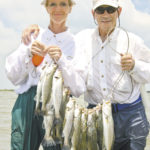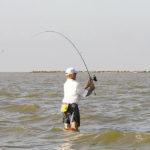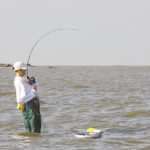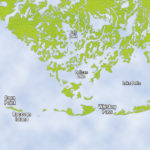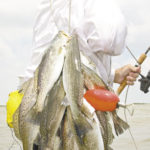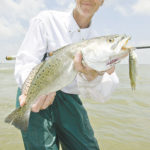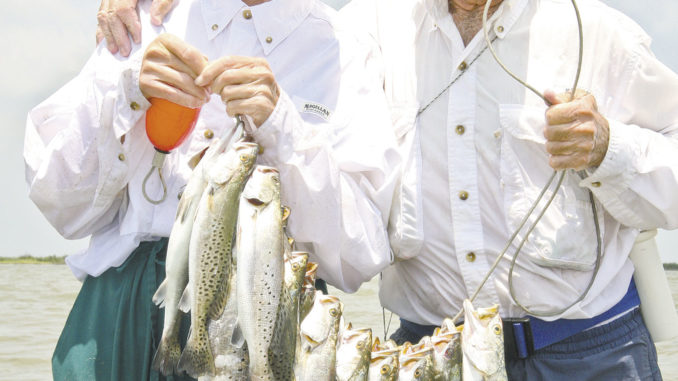
Cocodrie couple catches Whiskey Pass speckled trout
Things have changed an awful lot in Cocodrie since Dr. Sam Field started fishing down there in the 1970s. What used to be a rustic camp destination has turned into a refined resort of sorts.
Field identified a couple comfortable camps as we idled away from his waterfront lot in CoCo Marina.
“Look at that one,” he pointed out. “That one’s six, seven figures. Lots of things have changed down here over the years. Look at all these camps, all these boats. There’s one thing that hasn’t changed, though, and that’s the fishing.”
After retiring from a general-surgeon practice at The Baton Rouge Clinic, Field and his wife Michelle moved to Sunshine. And now they spend almost as much time at their Cocodrie camp as they do at home.
“I grew up bass fishing in Mississippi,” Field said. “And when I got to Baton Rouge, I kept on bass fishing. I fished the spillway, and would spend Sunday afternoons down there in 100-degree temperature and only catch three goggleye and two bass.
“I’d get back to the surgery lounge on Monday morning and the other surgeons were talking about how they caught two ice boxes full of speckled trout. I said, ‘Man, what is wrong with this picture?’ So I came down here and started fishing, and I haven’t stopped yet.”
The Fields are dyed-in-the-wool wade anglers, so the only reason they need a boat is to take them to the barrier islands during the summer. One of their favorite places to wade is Coon Point on the western end of Raccoon Island, so that’s where Field pointed his Triton bay boat after idling past the marina.
We arrived at Coon Point about 40 minutes later, and it was obvious that we went the wrong direction. Even though the wind was calm on this trip, it had been whipping the days prior, and the water hadn’t settled down yet; it was a hazy shade of gray.
And the more Coon Point came into our view, the more we realized that there were already several anglers wade fishing Field’s preferred spot. We didn’t run all this way to turn around without trying, though, so Field anchored his boat. He and Michelle were 50 yards from their boat before I could even get in the water.
By the time I hung my legs over to jump in, they were already coming back. They had judged the water to be too dirty, and some of the other waders had made a beeline to the pocket they were fishing behind the rocks on the Gulf side as if they and the Fields were old friends.
After a quick move to the north side of Coon Point, where Field thought we might find some better water, we thought things were going to pick up as Michelle landed a 2-pound trout on her fourth cast.
We spread out and worked toward a depression that cuts between Coon Point and Raccoon Island. The Fields had caught their limits of trout in this same spot only a couple weeks before during unseasonably cool weather.
“Our teeth were chattering because it was so cold,” Michelle Field said. “But the fish were here, so we stuck it out.
“I thought they were still here after catching that first fish, but it’s been nothing but catfish since.”
An air of desperation hung over the boat as we loaded back up. Field thought we could find some cleaner water if we headed back to the east. A spot came to his mind where he caught some trout wade fishing in the past, but he hadn’t fished this particular spot in more than two years.
The water definitely got clearer as we moved east, and Field soon spotted two waders already in the water around Whiskey Island. But he gave them their distance and idled to a small spot of water where the surf was crashing over a submerged island just off the edge of Whiskey Pass. It was the best-looking water we had seen all day.
I offered up a gratuitous suggestion that I had a good feeling about this spot.
“I sure hope so,” said Field as we walked toward the top of the island. “I don’t want this to be a water haul. Haven’t fished here in a couple years, but we’ve done well at this spot before. Maybe they’ll be here today.”
Following Michelle’s lead, I had filled up a minnow bucket with some live ones before grabbing my Carolina-rig rod and jumping in the water. I made a cast toward the back side of the island as I walked, and immediately hooked up with a good trout.
While reeling in my fish, I noticed that Michelle’s rod was bowed up as well. Field was still walking and throwing his tandem-rigged sparkle beetles, and as of yet, hadn’t hooked up. Two fish on the live minnows had him wondering if he should walk back to the boat to grab a handful of his own.
And then it was like somebody flipped the proverbial switch. The tide was pushing against us as we cast toward the open water of the Gulf of Mexico, and the Fields theorized that was what had the trout feeding in the shallow water off the edge of this island.
In fact, the trout were so shallow that Field hooked a couple fish while his bait was just dangling in the water while he was trying to take fish from his net and unhook them. In other words, we were standing right in the middle of the fish.
The bite was just about every cast for the next several minutes. I wound up walking back to the boat to put up my rod and grab the video camera to do a little video for LouisianaSportsman.com, and the action continued to be fast while I filmed.
However, by the time I walked to put up the camera and grab my fishing pole and came back, the bite had slowed considerably. I immediately noticed that our fish baskets and live bait buckets were now being pulled out to the Gulf of Mexico rather than pushed behind us.
The tide had switched, and we saw that the boats that had gathered in deep water out in front of us started catching fish every cast. Michelle thought the changing tide might have pulled the trout out to deeper water, so we started walking toward the boats.
Sure enough, we found them out in the deeper water. And the funny thing was the fish seemed to be schooled up based on size. One spot would give up only 12-inch keepers, while a spot 50 yards away produced nothing but 2-pounders.
Although he had walked back to his boat to grab some live minnows, Field only used them a few times. He mainly stuck with his plastics, and he picked up quite a few doubles on his tandem-rigged sparkle beetles. And whether it was the sparkle beetles or the live minnows, most of the trout grabbed our baits just as soon as they hit the water.
Eventually all the action came to an end as the boats around us must have filled their limits and started leaving. As we put our last fish on Field’s stringer, we thought how odd it was that less than an hour earlier we were talking about calling the day and rescheduling for another.
“That’s the way it can be down here on these islands,” Field said. “There are fish all over down here during the summer, so if you aren’t catching anything where you are, try moving around until you find the conditions to your favor.
“As you could tell here, if the trout are there, you’ll know in your first few casts.”
Above all, Field believes the No. 1 factor in finding feeding trout is to find the clearest water around the islands. Only when he finds good water does he even pay attention to the other variables that might point out where the fish are hiding.
“We fished dirty water today and caught one trout,” Field said. “We found some better-looking water and caught 74. Where do you want to fish?”
As we polished off some speckled trout salad sandwiches that Michelle had prepared earlier that morning, I brought up how I might like to make a return trip with them even though we didn’t need to now after filling their cooler full of 75 trout.
“When can you make it back,” Field asked, “because we’re fishing again in the morning?”
